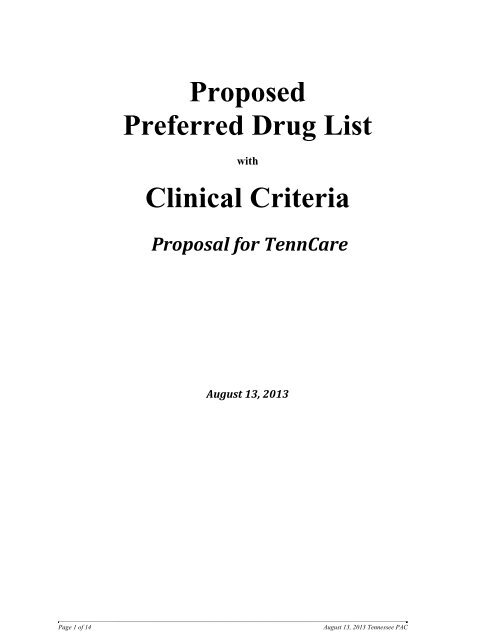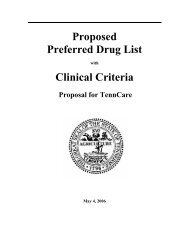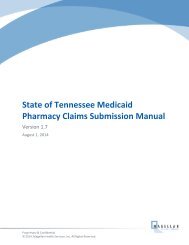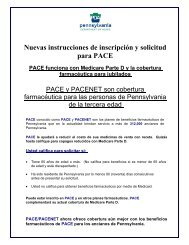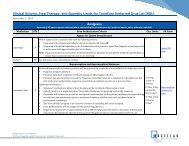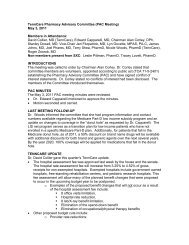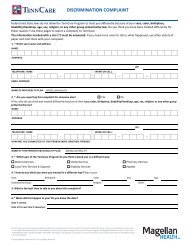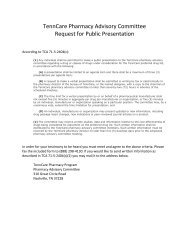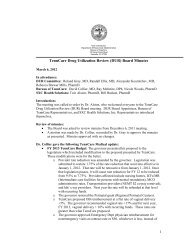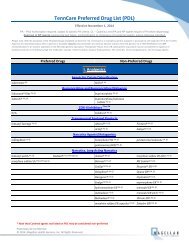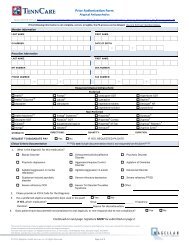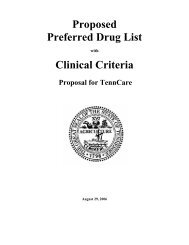Drug: ACCUTANE - Magellan Health Services || TennCare Portal
Drug: ACCUTANE - Magellan Health Services || TennCare Portal
Drug: ACCUTANE - Magellan Health Services || TennCare Portal
You also want an ePaper? Increase the reach of your titles
YUMPU automatically turns print PDFs into web optimized ePapers that Google loves.
Proposed<br />
Preferred <strong>Drug</strong> List<br />
with<br />
Clinical Criteria<br />
Proposal for <strong>TennCare</strong><br />
August 13, 2013<br />
Page 1 of 14<br />
August 13, 2013 Tennessee PAC
Responsibilities of the <strong>TennCare</strong> Pharmacy Advisory Committee<br />
Source: Tennessee Code/Title 71 Welfare/Chapter 5 Programs and <strong>Services</strong> for Poor<br />
Persons/Part 24 Tennessee <strong>TennCare</strong> Pharmacy Advisory Committee/71-5-2401 through 71-5-<br />
2404.<br />
<br />
<br />
<br />
Make recommendations regarding a preferred drug list (PDL) to govern all state expenditures<br />
for prescription drugs for the <strong>TennCare</strong> program.<br />
o The <strong>TennCare</strong> Pharmacy Advisory Committee shall submit to the bureau of<br />
<strong>TennCare</strong> both specific and general recommendations for drugs to be included on<br />
any state PDL adopted by the bureau. In making its recommendations, the<br />
committee shall consider factors including, but not limited to, efficacy, the use of<br />
generic drugs and therapeutic equivalent drugs, and cost information related to each<br />
drug. The committee shall also submit recommendations to the bureau regarding<br />
computerized, voice, and written prior authorization, including prior authorization<br />
criteria and step therapy.<br />
o The state <strong>TennCare</strong> pharmacy advisory committee shall include evidence-based<br />
research in making its recommendations for drugs to be included on the PDL.<br />
o The <strong>TennCare</strong> bureau shall consider the recommendations of the state <strong>TennCare</strong><br />
pharmacy advisory committee in amending or revising any PDL adopted by the<br />
bureau to apply to pharmacy expenditures within the <strong>TennCare</strong> program. The<br />
recommendations of the committee are advisory only and the bureau may adopt or<br />
amend a PDL regardless of whether it has received any recommendations from the<br />
committee. It is the legislative intent that, insofar as practical, the <strong>TennCare</strong> bureau<br />
shall have the benefit of the committee’s recommendations prior to implementing a<br />
PDL or portions thereof.<br />
Keep minutes of all meetings including votes on all recommendations regarding drugs to be<br />
included on the state preferred drug list<br />
The chair may request that other physicians, pharmacists, faculty members of institutions of<br />
higher learning, or medical experts who participate in various subspecialties act as<br />
consultants to the committee as needed.<br />
Page 2 of 14<br />
August 13, 2013 Tennessee PAC
PDL Decision Process<br />
The primary clinical decision that needs to be made is determining if the drugs within the<br />
therapeutic class of interest can be considered therapeutic alternatives.<br />
A Therapeutic Alternative is defined by the AMA as: “drug products with different chemical<br />
structures but which are of the same pharmacological and/or therapeutic class, and usually<br />
can be expected to have similar therapeutic effects and adverse reaction profiles when<br />
administered to patients in therapeutically equivalent doses” 1 .<br />
The Committee should not feel obligated to decide if every drug within the therapeutic class is<br />
exactly equal to all other drugs within the class, nor should they feel obligated to decide if<br />
every drug within the therapeutic class works equally well in every special patient population<br />
or in every disease.<br />
In special situations (e.g., presence of comorbid conditions) and in special populations (e.g.,<br />
pediatrics) use of a non-preferred drug might be the most appropriate therapy. These cases<br />
can be handled through prior authorization (PA). PA serves as a “safety valve” in that it<br />
facilitates use of the most appropriate agent regardless of PDL status.<br />
LENGTH OF AUTHORIZATIONS: Dependent upon diagnosis and length of therapy needed<br />
to treat. (Most medications are used chronically, and thus would be approved for 1 year.)<br />
1. Is there any reason the patient cannot be changed to a medication not requiring prior<br />
approval within the same class<br />
Acceptable reasons include:<br />
• Allergy to medications not requiring prior approval<br />
• Contraindication to or drug-to-drug interaction with medications not requiring prior<br />
approval<br />
• History of unacceptable/toxic side effects to medications not requiring prior approval<br />
2. The requested medication may be approved if both of the following are true:<br />
• If there has been a therapeutic failure of at least two medications within the same<br />
class not requiring prior approval (unless otherwise specified)<br />
• The requested medication’s corresponding generic (if a generic is available and<br />
preferred by the State) has been attempted and failed or is contraindicated<br />
3. The requested medication may be approved if the following is true:<br />
• An indication which is unique to a non-preferred agent and is supported by<br />
peer-reviewed literature or an FDA approved indication exists.<br />
----------------------------------------------------------------------------------------------------------------------------- ---<br />
The information provided for each drug class is organized into the following sections, when<br />
applicable:<br />
BACKGROUND:<br />
General overview<br />
Pharmacology<br />
Therapeutic effect(s)<br />
Adverse reactions<br />
Outcomes data<br />
Place in therapy according to current Treatment Guidelines<br />
RECOMMENDATION:<br />
General recommendation regarding utility and therapeutic equivalence among the agents<br />
in the class, as well as requirements for product availability (PDL placement)<br />
1 AMA Policy H-125.991 <strong>Drug</strong> Formularies and Therapeutic Interchange<br />
Page 3 of 14<br />
August 13, 2013 Tennessee PAC
BACKGROUND<br />
ENDOCRINE & METABOLIC AGENTS<br />
NEW: SODIUM-GLUCOSE CO-TRANSPORTER-2 (SGLT2) INHIBITOR<br />
<br />
<br />
<br />
<br />
Canagliflozin (Invokana) is a sodium-glucose co-transporter 2 (SGLT2) inhibitor. SGLT2<br />
is the transporter responsible for reabsorbing the majority of glucose filtered by the<br />
tubular lumen in the kidney. SGLT2 is expressed in the proximal renal tubules. By<br />
inhibiting SGLT2, canagliflozin reduces reabsorption of filtered glucose and lowers the<br />
renal threshold for glucose (RTG), and thereby increases urinary glucose excretion,<br />
improving blood glucose control.<br />
Canagliflozin is FDA-approved as as an adjunct to diet and exercise to improve glycemic<br />
control in adults with type 2 diabetes mellitus. Canagliflozin is not indicated for type 1<br />
diabetes or diabetic ketoacidosis.<br />
The most common adverse effects seen in clinical trials were genital mycotic infections,<br />
urinary tract infections, increased urination, vulvovaginal pruritis, thirst, constipation,<br />
nausea and abdominal pain. Other adverse effects include: asthenia, fatigue, acute or<br />
chronic pancreatitis, bone fracture, hypersensitivity reactions, photosensitivity, and<br />
volume depletion.<br />
o Canagliflozin is contraindicated in patients with severe renal impairment<br />
[estimated glomerular filtration rate (eGFR) less than 30 mL/min/1.73 m 2 ], end<br />
stage renal disease (ESRD), and in patients on dialysis.<br />
o Precautions:<br />
• Symptomatic hypotension can occur after starting canagliflozin as it<br />
causes intravascular volume contraction. Symptomatic hypotension<br />
occurs particularly in patients with impaired renal function (eGFR less<br />
than 60 mL/min/1.73 m 2 ), elderly patients, patients with low systolic blood<br />
pressure, and patients on diuretics or drugs which interfere with the<br />
renin-angiotensin-aldosterone system.<br />
• Canagliflozin can cause hyperkalemia. Patients with moderate renal<br />
impairment who are also taking medications that interfere with potassium<br />
excretion or the renin-angiotensin-aldosterone system are more<br />
susceptible to the development of hyperkalemia.<br />
• Canagliflozin may cause dose-related increases in low-densitylipoprotein<br />
cholesterol (LDL-C).<br />
• Canagliflozin is Pregnancy Category C.<br />
o <strong>Drug</strong>-<strong>Drug</strong> Interactions:<br />
• When administered with UDP-Glucuronosyl Transferase (UGT) enzyme<br />
inducers (e.g. rifampin, phenytoin, ritonavir, phenobarbital) the exposure<br />
of canagliflozin is reduced which may decrease the efficacy of<br />
canagliflozin.<br />
• Co-administration of digoxin and canagliflozin may increase the<br />
exposure to digoxin.<br />
Clinical Trials<br />
o<br />
A 26 week, double-blind, placebo- and active-controlled study was performed in<br />
1,284 patients with type 2 diabetes who were inadequately controlled on<br />
metformin monotherapy (greater than or equal to 2,000 mg/day, or at least 1,500<br />
mg/day if higher dose not tolerated) to assess the safety and efficacy of<br />
canagliflozin when combined with metformin. If patients were taking less than<br />
the required metformin dose or were taking metformin plus another<br />
antihyperglycemic (n=275) they were switched to metformin monotherapy for at<br />
least eight weeks before they were allowed to enter the two week, single-blind,<br />
placebo run-in. Patients who were already taking the required metformin dose<br />
(n=1,009) were immediately allowed to enter a two-week, single-blind, placebo<br />
run-in period. After completing the placebo run-in phase, patients were<br />
randomized to receive canagliflozin 100 mg, canagliflozin 300 mg, sitagliptin 100<br />
mg, or placebo once daily with metformin. The study indicated that canagliflozin<br />
100 mg and canagliflozin 300 mg once daily with metformin resulted in<br />
statistically significant improvements in HbA 1 C compared to placebo with<br />
Page 4 of 14<br />
August 13, 2013 Tennessee PAC
ENDOCRINE & METABOLIC AGENTS<br />
<br />
metformin (-0.79, -0.94, -0.17, p
ENDOCRINE & METABOLIC AGENTS<br />
RECOMMENDATION<br />
Canagliflozin is currently the only available sodium-glucose co-transporter 2 (SGLT2) inhibitor and<br />
is FDA-approved as an adjunct to diet and exercise to improve glycemic control in adults with type<br />
2 diabetes mellitus. While results from clinical trials demonstrate that canagliflozin is an efficacious<br />
agent in reducing HbA 1 C, PPG, and FPG, this agent is also associated with a number of adverse<br />
effects. The 2013 guidelines from the AACE suggest SGLT-2 inhibitors as a fifth, fourth, and third<br />
choice in monotherapy, dual therapy, and triple therapy, respectively for glycemic control. The<br />
guidelines also warn prescribers to use SGLT-2 inhibitors with caution as there are other<br />
antihyperglycemic agents with fewer adverse events and/or even possible benefits. Due to the<br />
fact that SGLT-2 inhibitors are not considered first line therapy and other antihyperglycemic agents<br />
are available with fewer adverse events, it is recommended that SGLT-2 inhibitors should be<br />
subject to prior authorization.<br />
COMMITTEE VOTE:<br />
APPROVED DISAPPROVED APPROVED with MODIFICATION<br />
PREFERRED<br />
N/A<br />
NEW: SGLT2 INHIBITOR<br />
NON-PREFERRED<br />
® PA, QL<br />
INVOKANA<br />
Class Prior Authorization Criteria for SGLT2 INHIBITORS<br />
Will be approved if ALL of the following are true:<br />
Diagnosis of Diabetes Type II, AND<br />
Patient’s HbA1c level is greater than 6.5 (for initial approval), AND<br />
Patient has tried and failed metformin or a metformin containing product (unless, recipient<br />
has an adverse reaction, intolerance or contraindication to metformin), AND<br />
Patient has tried and failed at least ONE agent from any 2 of the following classes:<br />
o DPP4 Inhibitor<br />
o Sulfonylurea<br />
o Incretin Mimetic<br />
o Insulin<br />
o TZD<br />
o Alpha-glucosidase inhibitor<br />
o Meglitinide<br />
COMMITTEE VOTE:<br />
APPROVED DISAPPROVED APPROVED with MODIFICATION<br />
Quantity Limits<br />
Invokana ®<br />
1/day<br />
COMMITTEE VOTE:<br />
APPROVED DISAPPROVED APPROVED with MODIFICATION<br />
References<br />
1. Facts and Comparisons on-line. Version 4.0; Wolters Kluwer <strong>Health</strong>, Inc.; 2013.<br />
Accessed July, 2013.<br />
2. Thompson MICROMEDEX on-line © 1974-2013. Accessed July, 2013.<br />
3. <strong>Magellan</strong> Medicaid Administration. Invokana New <strong>Drug</strong> Update. April, 2013.<br />
4. Invokana [package insert]. Titusville, NJ; Janssen Pharmaceuticals; March 2013.<br />
5. American Association of Clinical Endocrinologists. AACE Comprehensive Diabetes<br />
Management Algorithm. Endocrine Practice. 2013; 19(2): 327-336. Available at:<br />
http://aace.metapress.com/content/a38267720403k242/p=def7091b7a8144b4905138a3<br />
539d2ce5&pi=21. Accessed May 16, 2013.<br />
Page 6 of 14<br />
August 13, 2013 Tennessee PAC
GASTROINTESTINAL AGENTS<br />
BACKGROUND<br />
<br />
<br />
<br />
<br />
NEW: DICLEGIS<br />
Doxylamine succinate/pyridoxine HCL is a fixed combination of an anticholinergic<br />
antihistamine and a vitamin B6 analog indicated for the treatment of nausea and<br />
vomiting of pregnancy in women who do not respond to conservative<br />
management.<br />
The most common adverse effect occurring in ≥ five percent of patients reported<br />
was somnolence (14.3 percent). In post marketing, adverse effects that occurred<br />
include dyspnea, palpitations, tachycardia, vertigo visual disturbances,<br />
abdominal distension, anxiety, dysuria and rash.<br />
o Due to the anticholinergic antihistamine component it is not<br />
recommended to be used with central nervous system depressants<br />
including alcohol and should be used with caution in patients with asthma,<br />
increased intraocular pressure, narrow angle glaucoma, stenosing peptic<br />
ulcer, pyloroduodenal obstruction and urinary bladder-neck obstruction.<br />
o An extended anticholinergic effect may occur with concurrent use of an<br />
MOA inhibitor and doxylamine therefore it is not recommended. It should<br />
also not be administered with alcohol or other central nervous system<br />
(CNS) depressants.<br />
Nausea and vomiting of pregnancy symptoms was evaluated in a randomized,<br />
multicenter, double blind, placebo controlled study. With an intent to treat, the<br />
symptoms of a total of 256 pregnant patients, 18 years and older, with a seven to<br />
14 week gestation (median nine weeks of gestation) were randomized to receive<br />
Diclegis (n=131) or placebo (n=125) for 14 days. Nausea and vomiting symptoms<br />
were evaluated daily using the pregnancy unique quantification of emesis<br />
(PUQE) scale with the primary efficacy endpoint being measured from baseline<br />
to Day 15. At baseline, the mean PUQE score was 9 for Diclegis patients and<br />
8.8 for placebo patients. On Day 15, Diclegis demonstrated a 0.7 mean<br />
decrease in PUQE score compared to placebo (–4.8 ± 2.7 versus –3.9 ± 2.6;<br />
p=0.006).<br />
According to the American College of Obstetrician and Gynecologist (ACOG) and<br />
Association of Professors of Gynecology and Obstetrics, the treatment of nausea<br />
and vomiting of pregnancy also referred to as morning sickness with pyridoxine<br />
and vitamin B6 or vitamin B6 have been first-line recommendations for many<br />
years. Diclegis is the first FDA-approved, pregnancy category A delayed-release<br />
combination medication for the treatment of nausea and vomiting of pregnancy.<br />
RECOMMENDATION<br />
Doxylamine succinate/pyridoxine HCL is a fixed combination of an anticholinergic<br />
antihistamine and a vitamin B6 analog indicated for the treatment of nausea and vomiting<br />
of pregnancy in women who do not respond to conservative management. ACOG<br />
guidelines consider pyridoxine and vitamin B6 among the first-line recommendations for<br />
the treatment of nausea and vomiting of pregnancy. Therefore, it is recommended<br />
doxylamine succinate/pyridoxine should be available for the treatment of nausea and<br />
vomiting in pregnancy.<br />
COMMITTEE VOTE:<br />
APPROVED DISAPPROVED APPROVED with MODIFICATION<br />
Page 7 of 14<br />
August 13, 2013 Tennessee PAC
GASTROINTESTINAL AGENTS<br />
PREFERRED<br />
N/A<br />
NEW: DICLEGIS<br />
NON-PREFERRED<br />
DICLEGIS ® (doxylamine succinate/pyridoxine)<br />
Prior Authorization Criteria<br />
Diclegis will be approved for pregnant females.<br />
COMMITTEE VOTE:<br />
APPROVED DISAPPROVED APPROVED with MODIFICATION<br />
Quantity Limits<br />
Diclegis ®<br />
4/day<br />
COMMITTEE VOTE:<br />
APPROVED DISAPPROVED APPROVED with MODIFICATION<br />
References<br />
1. Facts and Comparisons on-line. Version 4.0; Wolters Kluwer <strong>Health</strong>, Inc.; 2013.<br />
Accessed July, 2013.<br />
2. Thompson MICROMEDEX on-line © 1974-2013. Accessed July, 2013.<br />
3. <strong>Magellan</strong> Medicaid Administration. Diclegis New <strong>Drug</strong> Update. May, 2013.<br />
4. Koren G, Clark S, Hankins GDV, et al. Effectiveness of delayed-release doxylamine and<br />
pyridoxine for nausea and vomiting of pregnancy: a randomized placebo controlled trial.<br />
Am J Obstet Gynecol. 2010; 203(6):571.e1-7. Available at:<br />
http://download.journals.elsevierhealth.com/pdfs/journals/0002-<br />
9378/PIIS0002937810009142.main-abr.pdfjid=ymob. Accessed May 29, 2013.<br />
5. American College of Obstetricians and Gynecologists. Nausea and vomiting of pregnancy.<br />
ACOG Practice Bulletin No. 52. Obstet Gynecol. 2004; 103:803-15. Available at:<br />
http://www.molinahealthcare.com/medicaid/providers/mo/pdf/acog%20nausea%20%20vo<br />
miting%20pregnancy.pdfE=true. Accessed May 29, 2013.<br />
Page 8 of 14<br />
August 13, 2013 Tennessee PAC
OPHTHALMIC AGENTS<br />
NEW: CYSTARAN<br />
BACKGROUND<br />
<br />
<br />
<br />
Cystinosis is a rare genetic metabolic disease affecting an estimated 2,000 individuals<br />
worldwide. Cystinosis causes accumulation of the amino acid in multiple organs of the<br />
body and without specific treatment patients typically develop end stage renal disease<br />
around the age of nine years. Excess cystine damages cells and commonly results in<br />
crystalline cystine formation that builds up in many tissues and organs causing significant<br />
issues. Eyes and kidneys are particularly vulnerable to cystine accumulation and<br />
damage; however, muscles, thyroid, pancreas and testes may also be affected.<br />
Cysteamine decreases the amount of cystine in the lysosomes of patients with cystinosis.<br />
Exogenous cysteamine enters the cell and converts cystine to cysteine and a cysteinecysteamine<br />
complex. Both cysteine and the cysteine-cysteamine complex are more<br />
readily transported out of the lysosome than cystine, resulting in a long-term depletion of<br />
lysosomal cystine.<br />
Ophthalmic cysteamine is indicated for use in the treatment of corneal cystine crystal<br />
accumulation in patients with the genetic disease cystinosis.<br />
In ophthalmic cysteamine clinical trials, the most commonly reported adverse reactions (≥<br />
ten percent) reported by patients were sensitivity to light, redness, eye pain/irritation,<br />
headache and visual field defects.<br />
<br />
<br />
o<br />
o<br />
There are no reported contraindications to ophthalmic cysteamine.<br />
Instances of benign intracranial hypertension (or pseudotumor cerebri) have<br />
been reported in patients receiving oral cysteamine therapy. These effects were<br />
resolved with the addition of diuretic therapy. Reports have also been received<br />
for patients using ophthalmic cysteamine, however it should be noted these<br />
patients were concomitantly receiving oral cysteamine therapy.<br />
o As this product is intended for topical ophthalmic therapy, no drug interactions<br />
have been reported.<br />
The clinical efficacy of cysteamine ophthalmic solution was evaluated in three controlled<br />
clinical trials consisting of approximately 300 patients diagnosed with cystinosis.<br />
Individuals were measured for their baseline Corneal Cystine Crystal Score (CCCS) prior<br />
to the initiation of cysteamine ophthalmic therapy. The primary efficacy end point for the<br />
trials was the response rate of eyes that demonstrated a reduction of at least one unit in<br />
the photo-rated CCCS at some time point during the study when the baseline CCCS for<br />
the individual was ≥1, or a lack of an increase of more than one unit in CCCS throughout<br />
the study for individuals whose pre-treatment baseline CCCS was
OPHTHALMIC AGENTS<br />
RECOMMENDATION<br />
Cysteamine ophthalmic solution is a new, novel entity that provides a reduction cystine crystalline<br />
accumulation in the cornea of patients diagnosed with Cystinosis. There are currently no other<br />
commercial ophthalmic products used to treat corneal cystine accumulation and systemic<br />
cysteamine therapy has generally proven ineffective in preventing corneal accumulation. Use of<br />
this medication offers patients the possibility of reduced incidence of blindness often experienced<br />
by individuals with the genetic disorder. Therefore, it is recommended Cysteamine ophthalmic<br />
solution should be available for use in patients with Cystinosis.<br />
COMMITTEE VOTE:<br />
APPROVED DISAPPROVED APPROVED with MODIFICATION<br />
PREFERRED<br />
N/A<br />
NEW: CYSTARAN<br />
NON-PREFERRED<br />
CYSTARAN ® (cysteamine hydrocholride)<br />
Prior Authorization Criteria<br />
Cystaran will be approved for patients with a diagnosis of cystinosis.<br />
COMMITTEE VOTE:<br />
APPROVED DISAPPROVED APPROVED with MODIFICATION<br />
References<br />
1. Facts and Comparisons on-line. Version 4.0; Wolters Kluwer <strong>Health</strong>, Inc.; 2013.<br />
Accessed July, 2013.<br />
2. Thompson MICROMEDEX on-line © 1974-2013. Accessed July, 2013.<br />
3. <strong>Magellan</strong> Medicaid Administration. Cystaran New <strong>Drug</strong> Update. May, 2013.<br />
4. Cystaran [package insert]. Gaithersburg, MD; Sigma-Tau Pharmaceuticals; October 2012.<br />
Page 10 of 14<br />
August 13, 2013 Tennessee PAC
Prior Authorization Criteria for Tecfidera ®<br />
CRITERIA FOR REVIEW<br />
Will be approved for recipients with a diagnosis of relapsing, remitting Multiple Sclerosis (RRMS)<br />
who meet ONE of the following criteria:<br />
Trial and failure of interferon ß or glatiramer<br />
Contraindication, drug-drug interaction, or intolerance to BOTH interferon ß and<br />
glatiramer<br />
COMMITTEE VOTE:<br />
APPROVED DISAPPROVED APPROVED with MODIFICATION<br />
Quantity Limits<br />
Tecfidera ®<br />
2/day<br />
COMMITTEE VOTE:<br />
APPROVED DISAPPROVED APPROVED with MODIFICATION<br />
Prior Authorization Criteria for Namenda XR ®<br />
Will be approved for recipients who meet ALL of the following criteria:<br />
Diagnosis of Alzheimer's disease<br />
Trial and failure of cholinesterase inhibitor<br />
Documented intolerance or contraindication to an inactive ingredient that is present in the<br />
regular-release product, but NOT in the XR product<br />
COMMITTEE VOTE:<br />
APPROVED DISAPPROVED APPROVED with MODIFICATION<br />
Quantity Limits<br />
Namenda XR ®<br />
1/day<br />
COMMITTEE VOTE:<br />
APPROVED DISAPPROVED APPROVED with MODIFICATION<br />
Page 11 of 14<br />
August 13, 2013 Tennessee PAC
Prior Authorization Criteria for Amitiza ®<br />
CRITERIA FOR REVIEW<br />
Approval for Amitiza® will be granted upon documentation of:<br />
Diagnosis of idiopathic chronic constipation AND<br />
o Trial and failure of at least ONE agent from TWO of the following classes (as<br />
confirmed by paid claims by <strong>TennCare</strong>):<br />
• Osmotic laxatives<br />
• Bulk-forming laxatives<br />
• Stimulant laxatives, OR<br />
Diagnosis of constipation predominate irritable bowel syndrome (IBS) in female, AND<br />
o Trial and failure of at least ONE agent from TWO of the following classes (as<br />
confirmed by paid claims by <strong>TennCare</strong>):<br />
• Osmotic laxatives<br />
• Bulk-forming laxatives<br />
• Stimulant laxatives, OR<br />
Diagnosis of opioid induced consiptation in chronic non-cancer pain, AND<br />
o Documentation of paid claims by <strong>TennCare</strong> for opioids for at least 150 out of 180<br />
days, AND<br />
o Trial and failure of both PEG and Lactulose (as confirmed by paid claims by<br />
<strong>TennCare</strong>)<br />
COMMITTEE VOTE:<br />
APPROVED DISAPPROVED APPROVED with MODIFICATION<br />
Prior Authorization Criteria for Simbrinza ®<br />
Simbrinza ® will be approved if the following criteria is met:<br />
Patient is on simultaneous therapy with brimonidine and Azopt ® for at least 60 days<br />
Clinically valid reason why patient cannot take 2 agent seperately.<br />
COMMITTEE VOTE:<br />
APPROVED DISAPPROVED APPROVED with MODIFICATION<br />
Prior Authorization Criteria for Vecamyl ®<br />
Vecamyl will be approved for patients meeting ALL of the following criteria:<br />
Diagnosis of Essential Hypertension or Malignant Hypertension, AND<br />
Trial and failure, contraindication or intolerance to ALL of the following:<br />
o ACE inhibitor or ARB plus a diuretic; AND<br />
o Beta blocker plus a diuretic, AND<br />
o Clonidine, AND<br />
o Hydralazine<br />
COMMITTEE VOTE:<br />
APPROVED DISAPPROVED APPROVED with MODIFICATION<br />
Quantity Limits<br />
Vecamyl ®<br />
10/day<br />
COMMITTEE VOTE:<br />
APPROVED DISAPPROVED APPROVED with MODIFICATION<br />
Page 12 of 14<br />
August 13, 2013 Tennessee PAC
CRITERIA FOR REVIEW<br />
Prior Authorization Criteria for Liptruzet ®<br />
Liptruzet ® will be approved for patients meeting ALL of the following criteria:<br />
Patient already concommitantly receiving atorvatatin + Zetia, AND<br />
Clinically valid reason why the patient cannot take the two agents seperately<br />
COMMITTEE VOTE:<br />
APPROVED DISAPPROVED APPROVED with MODIFICATION<br />
Prior Authorization Criteria for Signifor ®<br />
Signifor will be approved for patients meeting ALL of the following criteria:<br />
Diagnosis of Cushing’s Disease or Cushing’s Syndrome, AND<br />
Patient has failed surgery (i.e., pituitary, adrenal gland, pancreas tumor removal); OR<br />
patient is not a candidate for surgery<br />
COMMITTEE VOTE:<br />
APPROVED DISAPPROVED APPROVED with MODIFICATION<br />
Quantity Limits<br />
Signifor ®<br />
2 ampules/day<br />
COMMITTEE VOTE:<br />
APPROVED DISAPPROVED APPROVED with MODIFICATION<br />
Prior Authorization Criteria for Simponi ®<br />
For a diagnosis of Ankylosing Spondylitis:<br />
Enbrel®, Humira® or Simponi® will be approved for patients who have failed an<br />
adequate trial of TWO NSAIDs (unless contraindicated).<br />
Recipients will have to try and fail (or have an intolerance or contraindication to) Enbrel ®<br />
AND Humira® prior to receiving approval for Simponi®<br />
For a diagnosis of Rheumatoid Arthritis:<br />
Enbrel®, Humira®, Kineret®, Cimzia®, Orencia® or Simponi® will be approved for<br />
patients meeting the following criteria:<br />
o<br />
o<br />
Patient must have failed or been intolerant to at least methotrexate (unless there<br />
is a documented absolute contraindication such as alcohol abuse, cirrhosis,<br />
chronic liver disease) AND one other DMARD.<br />
For recipients who have a contraindication to methotrexate, only one DMARD<br />
must be tried and failed.<br />
Recipients will have to try and fail (or have an intolerance or contraindication to) Enbrel ®<br />
AND Humira® prior to receiving approval for Simponi®<br />
For a diagnosis of Psoriatic Arthritis:<br />
<br />
Enbrel®, Humira®, or Simponi® will be approved for patients who have failed an<br />
adequate trial of methotrexate (unless contraindicated)<br />
Recipients will have to try and fail (or have an intolerance or contraindication to) Enbrel ®<br />
AND Humira® prior to receiving approval for Simponi®<br />
For a diagnosis of Ulcerative Colitis:<br />
<br />
<br />
Humira ® or Simponi ® will be approved for patients who have tried and failed a<br />
corticosteroid OR an immunosuppressive agent.<br />
Recipients will have to try and fail (or have an intolerance or contraindication to) Humira®<br />
prior to receiving approval for Simponi®<br />
Page 13 of 14<br />
August 13, 2013 Tennessee PAC
CRITERIA FOR REVIEW<br />
COMMITTEE VOTE:<br />
APPROVED DISAPPROVED APPROVED with MODIFICATION<br />
Page 14 of 14<br />
August 13, 2013 Tennessee PAC


